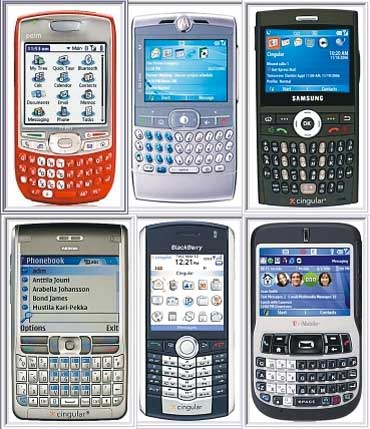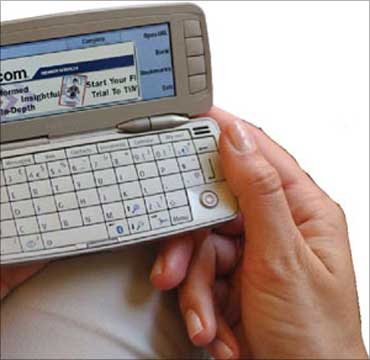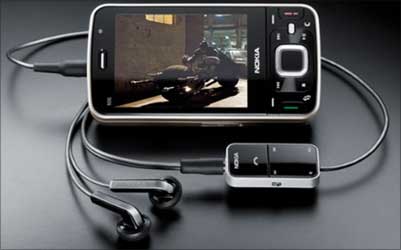
Telecom players are set to use 3G technology to woo the ever-expanding mobile user base with value-added services and much higher speeds.
Mumbaikar Aditya Deshpande is among the 1,650,000 users who subscribe to state-run BSNL and MTNL's third generation (3G) services.
"I bought a 3G connection from MTNL as I wanted to try the much-talked about services. I also have a Vodafone connection. But, having used 3G speeds, I know it is a completely different experience," says an enthused Deshpande.
He has used his 3G mobile to connect his laptop to the internet, too. "I love downloading videos from the net and sharing them, and the browsing speed is better than many broadband connections available today," he adds.
Welcome to the world of 3G wireless technology, which promises to add more spice (or speed) to your web experience. Telecom players and value-added service providers have already started discussions on which services will get them maximum usage on 3G networks.
And why not? After all, there is enough demand. According to a survey by the mobile analytics company, Informate Mobile Intelligence, three out of four current GPRS users would like to access 3G services in the future and close to 63 per cent of mobile users in the 25-30 age group figure in the 'very likely' to shift category.
Click on NEXT to read more...

Another report adds India already has 149 million mobile data users, with 50-60 million 3G handsets.
A one per cent broadband penetration simply adds to the opportunity. With less than five of the eleven 2G operators winning 3G licenses in each circle, the operators are expected to target the high-end subscribers of competing operators.
This will open a potential $3-4 billion market share gain opportunity, estimates Goldman Sachs in a research report.
So, what's in store for India's over 500 million mobile users? In the immediate future, perhaps very basic VAS services. But, within the VAS category, analysts expect telecom operators will focus on improving their current services.
"Voice, short messages (SMSes) and other data-based VAS will be the focus of most telcos and it will be in that order. In India, voice and SMSes are the most used services. To change this overnight is not possible. Besides, how many users use smartphones that will help them access data that is 3G-ready?" questions Alok Shende, principal analyst, Ascentius Consulting.
He further adds: "A lot depends on the handset usage pattern. So, there will be handsets that are 3G-powered, but act as a connection for browsing the net on computers. And, there would be mobile phones that are smartphones and, hence, used for browsing."
Click on NEXT to read more...

A survey from Informate says basic 3G-based services will dominate. "Browsing accounts for 30 per cent of the total time spent on smartphones (both Symbian and Windows operating system-based), followed by media players at 13 per cent."
VAS providers like OnMobile and Hungama also believe that, for starters, existing offerings should see an increased adoption. "Also, video streaming, mobile TV and mobile clips will see some traction," says Arvind Rao, CEO and co-founder of OnMobile.
The company is already working on eight mobile services that will be launched for 3G networks. Siddhartha Roy, chief operating officer of Hungama Digital, agrees: "I think full track music will also see an uptick. It is already a hit among users who have access to 2.5G networks. Rich media content like location-based information will be much more widely available," opines Roy.
Bharat Sanchar Nigam Ltd and Mahanagar Telephone Nigam Ltd have in the last one year managed to increase their 3G user base to 400,000 subscribers (in just New Delhi and Mumbai circles).
One of the most used applications on their 3G networks has been music video downloads, followed by video calls. Local video calls on BSNL are charged at 70 paise a minute and STD video calls at Re 1 a minute.
Click on NEXT to read more...

Internet browsing will be an application that will be the key and industry players believe adoption will be based on pricing.
"Mobile web browsing will definitely be the lumpsum in 3G. Data will have two packages - sachet and pay per use. Sachet data plans will be for users who want limited usage, whereas pay per use will target high-end users," inform sources close to telecom operators.
But, Rajesh Reddy, co-founder and CEO of July Systems, is voting for flat data plans that could lift data usage on 3G networks.
Vignettes from 3G's future
Are you are intrigued about what's cooking at your telecom provider's R&D labs that will complement 3G networks? Here's a snapshot of services and applications that could be offered to you when 3G networks roll out later this year.
Music
Music, by far, is the most popular application. Caller tunes and ringback tones constitute nearly 40 per cent of the VAS segment today. With existing 3G users getting access to better speeds, full-version soundtracks are downloaded by 95 per cent of mobile phone users.
Add to this the ability to download music videos. Hungama and OnMobile, which already lead in the music category, assert this will be a segment to watch out for with 3G networks.
Click on NEXT to read more...

Video streaming and downloads
Streaming of complete songs, mobile TV, exchange of videos in the person-to-person (P2P) category and video-on-demand will catch up. Usage of mobile TV and videos is already 8-10 per cent of the VAS portfolio.
But, with 3G data speeds, usage is set to rise. "We have seen video download size increasing from one-and-a-half minutes to three minutes in cities where 2.5G has been launched. With 3G, this will only increase," says Roy of Hungama.
But Rakesh Reddy, co-founder and CEO of July Systems, says consumer confidence is a huge issue.
"We had 10 million people using our platforms to access live video streaming of Indian Premier League 3 matches on mobile.
But, we faced a peculiar problem. Despite the video downloads being free, people were hesitant to try the service as they were apprehensive," says Reddy. According to him, sports is a genre that will be popular in video.
Click on NEXT to read more...

Video calling
Video calling is another ready-to-launch service on 3G networks. At present, BSNL offers a data pack wherein a local video call is charged at 70 paise a minute and an STD call is charged at Re 1 a minute - roughly twice the audio call tariffs.
But the service, however, has not found too many takers among BSNL and MTNL's 3G user base.
"Our 3G consumers are into internet surfing. Video calling has not taken off because many users do not have handsets that offer good quality calling," claims a senior official from MTNL.
Analysts say video calling with 3G networks is not a very popular application even in developed countries. But, they stress that each market behaves differently.
"It is not that video calling has not picked up. It has become very popular in Japan," argues Shobhit Agarwal, director, Protiviti Consulting.
Click on NEXT to read more...

Games
Adoption of games, especially online mobile games, has been stifled, primarily due to lack of bandwidth. "Since speeds were insufficient on 2G networks, developers were building smaller basic games that ran offline.
But, with 3G, Nazara is developing a multiplayer game that not only will be accessible across carrier platforms but will also be telecom operator agnostic," says Nitish Mittersain, CEO, Nazara Technologies.
A reality check on 3G costs
Worried about overshooting your monthly phone bill limits with 3G networks? Don't be.
While telecom operators chose to be non-committal on 3G service and data pricing, we spoke to several industry experts and analysts to ascertain what could be the actual cost for subscribing to 3G.
There is no clear consensus on pricing of 3G services yet. So, while there is a section that feels that telecom operators will not touch the price and focus on volumes, another section claims 3G are premium services and, hence, consumers will have to shell out more.
"3G prices cannot be very high, as users may reject it then. So, to begin with, operators will have to go with a price point that is similar to 2G prices.
Once they hook users to it, they can change the pricing. However, initially, they will not see a big change from existing pricing," estimates Romal Shetty of KPMG.
Click on NEXT to read more...

But, many feel India is such a competitive market that a price war is inevitable.
"Since mobile Internet access will be the single-most widely-used service in 3G, telecom networks will become a dumb pipe for data access. If that happens, there will be a price-war in this segment, like what we see in voice today," says Arvind Rao of Onmobile.
However, sources close to telecom operators confirmed 3G would be at a premium, compared to 2G services.
The fact that BSNL had to cut its 3G service prices twice to attract users says a lot about the actual behaviour of users when it comes to paying for 3G services. BSNL data service plans start at Rs 249 a month for prepaid subscribers, where the highest data charge is Rs 1 for each MB.
To begin with, there are two elements associated with the upgrade from 2G to 3G. One is the migration fee for an existing subscriber and, second, is the increase in service fees.
"With the entry of other mobile network operators in the 3G space, the fee to migrate from 2G to 3G is expected to decline and might even become zero," says Abhishek Khanna, group manager, Evalueserve.